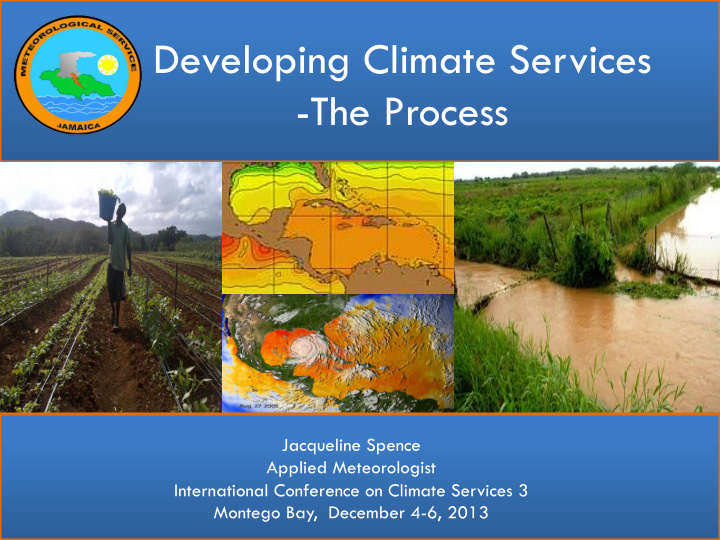



Developing Climate Services -The Process Jacqueline Spence Applied Meteorologist International Conference on Climate Services 3 Montego Bay, December 4-6, 2013
CONTENTS Stakeholder ¡Mee-ngs ¡and ¡Consulta-ons The ¡CAMI ¡Project ¡ Identification of Partners ¡ TOR ¡for ¡Working ¡Groups ¡ ¡ Accomplishments ¡and ¡Future ¡Work ¡ Climate ¡Informa-on ¡Tools ¡workshop ¡
Stakeholder ¡Mee-ngs ¡and ¡Consulta-ons • ¡ Met Office, USAID and IRI – May 2013. • Meetings held with key stakeholders – MWLECC, RADA, Forestry, NEPA, CARDI, WRA, NIC,ODPEM • Bring awareness to what exactly is Climate services and what it means for each stakeholder/sector • Informs Policy decision process • Incorporating tools and strategies to effectively manage climate risks and take advantage of opportunities. • Collaborative effort
Stakeholder ¡Mee-ngs ¡and ¡Consulta-ons • ¡ Break out groups formed • Persons were given questions which guided the discussion about climate services. • Questions asked: • Current source for weather and climate information? • What information and tools were needed and their uses? • Gap identification?
Stakeholder ¡Mee-ngs ¡and ¡Consulta-ons • ¡ Common information needed across stakeholders included: • Meteorological parameters • Short term weather forecast • Soil moisture and temperature data • Uses: • Planning for policy and local • Research and monitoring • Crop Modelling • Pest and Disease modelling • Early warning system
Stakeholder ¡Mee-ngs ¡and ¡Consulta-ons • ¡ Gap Recognition • Several organizations doing similar activity so the need for greater collaboration. • Forest fires need to be linked to drought. • Soil moisture measurements necessary • Insufficient stations with climatological information • Seasonal forecast drivers – early/late rainfall season • Data clearing house required – governance
Stakeholder ¡Mee-ngs ¡and ¡Consulta-ons FOCUS ¡GROUPS ¡ • ¡ ¡ Individual consultations were then conducted to determine priorities of the different agencies and what was possible • Target date for the development of actual products was the ICCS3 in December 2013. • Based on these meetings it was decided that working with the Agricultural sector would be most feasible due to ground work already done through Caribbean Agro-Meteorological Initiative (CAMI) project.
The ¡CAMI ¡Project ¡ • Funded by the European Union’s ACP Science and Technology Programme. • Partnership between CIMH (Applicant), WMO, CARDI, Ten Meteorological Services. • Ten Met Services –Antigua & Barbuda, T&T, Dominica, Jamaica, Belize, Barbados, Guyana, Grenada, SVG and St. Lucia. ¡
CAMI • Increase and 1 ¡ sustain OBJECTIVES ¡ agricultural productivity • Improved 2 ¡ dissemination of information 3 ¡ • Improved application of information 4 ¡ • Products targeted to small farmers
¡CAMI ¡Ac-vi-es ¡and ¡Training • ¡ ¡ Data rescue for the Meteorological Departments in the participating countries • Farmers fora in the countries • Statistics in Applied Climatology – online course. • Pest and Disease Modelling. • Crop Simulation Modelling. • Training in developing bulletins, newsletters and other information publications.
Identification of Partners ¡ RADA ¡ MOA ¡ MET ¡ CARDI ¡ ACDI ¡ VOCA ¡
TOR ¡for ¡Working ¡Groups ¡ ¡ • A working group comprising MSJ, RADA, CARDI, Min. of Ag. and ACDI VOCA will develop a climate service objective, in support of national food security goals. • The Working Group will develop a work plan to achieve its ¡ ¡ objective. The Work Plan will include milestones, roles, and responsibilities • The Working Group will seek high-level endorsement of the work plan and be empowered to implement the work plan. ¡
TOR ¡for ¡Working ¡Groups ¡ ¡ • The Working Group will establish a schedule of work and meetings, leadership representing the MSJ and RADA. • The Working Group will establish a process for updating its high level sponsors and management about progress in its work plan.
Accomplishments ¡ Training of Revision Extension of CAMI Drought Predictor Staff bulletins • Drought prediction • Improve • Delivery of tool will better communication and information and inform planning awareness Advisories • Current drought • Develop capacity to • Identification of monitoring tool will utilize climate gaps. validate the products and prediction information.
Future ¡Work ¡ Soil Water Fire Pest and Balance Potential Disease tool tool Model • Pilot project for • Pilot for St. • Validate model Irish potato. Elizabeth developed for selected areas • Develop a • Develop a forecast tool forecast tool • Extend to other areas
Soil ¡Moisture ¡Balance ¡tool ¡for ¡Irish ¡Potato ¡– ¡Data ¡ Prepara-on ¡ Data requirements ¡ • Daily rainfall and temperature data • Shape files for soil types • Calculate Kc – crop coefficient for Irish potato ET = Kc ET o • Calculate Total available water (TAW) for the different soil types . TAW =( FC – PWP) * depth. • Root depth and planting dates is also required. ¡
¡ ¡ Crop ¡Coefficient ¡ ¡Curve ¡for ¡Irish ¡Potato ¡ ¡ Kc ¡mid ¡ Kc ¡end ¡ Kc ¡ini ¡ Crop ¡ Mid-‑ ¡ Late ¡ development ¡ Ini-al ¡ season ¡ season ¡
¡ ¡ Soil ¡Moisture ¡Balance ¡tool ¡for ¡Irish ¡Potato ¡– ¡IRI ¡Data ¡ Library ¡ • Algorithm for SWB was done in data library – Produces time series as well as maps – Seasonal averages could also be done
¡ ¡ Eleva-on ¡grid ¡showing ¡loca-ons ¡used ¡
¡ ¡ Total ¡available ¡Water ¡(TAW) ¡profile ¡for ¡the ¡island ¡
¡ ¡ Soil ¡moisture ¡for ¡Jan-‑Feb ¡2012 ¡
¡ ¡ Yearly ¡Time ¡series ¡of ¡Jan-‑Feb ¡averaged ¡Soil ¡moisture ¡ for ¡Silt ¡Loam ¡
¡ ¡ CONCLUSION ¡ • Working group developed work plan • Accomplished tasks • Way forward in terms of additional products/ collaboration with other stakeholders • Highlight work done from Climate tools workshop held at IRI in New York
Recommend
More recommend